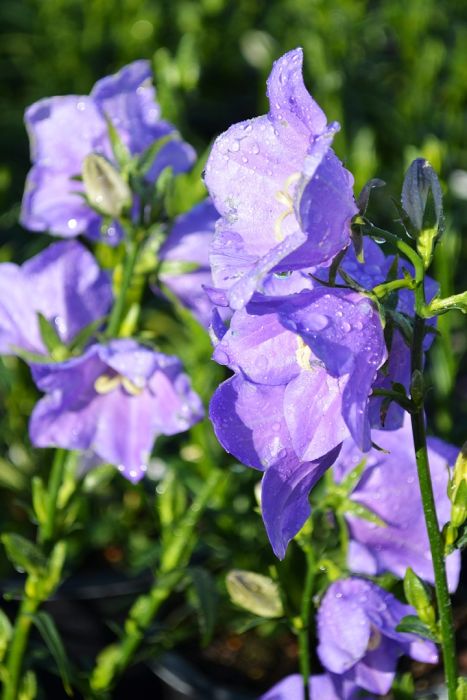Campanula, Peach-Leaved Bellflower 'Takion Blue'



Out of stock
Coming soon, still growing- Sun Preference
- Full-Sun, Part-Sun
- Bloom Time
- June, July, August
Description
This large, diverse group of plants includes creeping groundcovers, dwarfs, and large upright perennials. Plants are rewarding and easy to grow in rich, moist but well-drained soil. Bellflower (Campanulas) generally do not thrive in nonamended clay soil. Many varieties bloom for a long period of time.
Takion Blue Campanula is a compact plant that produces a profusion of lavender blue flowers from early to late summer. Strong stemmed flowers are aligned upward and outward producing a fuller, more showy display.
Minnesota's Largest Selection of Perennials
Discover an unparalleled selection of perennials at Gertens! With the largest variety in Minnesota, we offer endless options of colorful perennials, natives, and pollinator plants to beautify your garden year after year. From vibrant flowers to lush foliage, our perennials are perfect for adding beauty and charm to your outdoor space. Visit Gertens today and see why we're known as Minnesota's Destination Garden Center!
Details
Campanula persicifolia ‘Takion Blue’ | Takion Blue Campanula
Height: 20 inches
Spread: 16 inches
Sunlight: ![]()
![]()
Hardiness Zone: 3a
Description:
Captivating violet-blue bells are scattered among the attractive, bright green, strappy leaves; a low spreading growth habit; beautiful in mass plantings, thrives in well drained, moist areas
Ornamental Features
Takion Blue Peachleaf Bellflower is smothered in stunning blue bell-shaped flowers with violet overtones at the ends of the stems from late spring to early summer. Its narrow leaves remain emerald green in color throughout the season. The fruit is not ornamentally significant.
Landscape Attributes
Takion Blue Peachleaf Bellflower is an herbaceous perennial with a mounded form. Its relatively fine texture sets it apart from other garden plants with less refined foliage.
This plant will require occasional maintenance and upkeep, and is best cleaned up in early spring before it resumes active growth for the season. Gardeners should be aware of the following characteristic(s) that may warrant special consideration;
- Self-Seeding
Takion Blue Peachleaf Bellflower is recommended for the following landscape applications;
- Mass Planting
- Rock/Alpine Gardens
- Border Edging
- General Garden Use
- Container Planting
Planting & Growing
Takion Blue Peachleaf Bellflower will grow to be about 20 inches tall at maturity, with a spread of 16 inches. Its foliage tends to remain dense right to the ground, not requiring facer plants in front. It grows at a fast rate, and under ideal conditions can be expected to live for approximately 5 years.
This plant does best in full sun to partial shade. It prefers to grow in average to moist conditions, and shouldn't be allowed to dry out. It is not particular as to soil type or pH. It is highly tolerant of urban pollution and will even thrive in inner city environments. This is a selected variety of a species not originally from North America. It can be propagated by division; however, as a cultivated variety, be aware that it may be subject to certain restrictions or prohibitions on propagation.
Takion Blue Peachleaf Bellflower is a fine choice for the garden, but it is also a good selection for planting in outdoor pots and containers. It can be used either as 'filler' or as a 'thriller' in the 'spiller-thriller-filler' container combination, depending on the height and form of the other plants used in the container planting. Note that when growing plants in outdoor containers and baskets, they may require more frequent waterings than they would in the yard or garden. Be aware that in our climate, most plants cannot be expected to survive the winter if left in containers outdoors, and this plant is no exception. Contact our store for more information on how to protect it over the winter months.
| SKU | Container Size |
| P1112 | #1 Container (1 Gallon) |
* Not all container sizes may be available at this time. See store for details on specific container size availability.
More Information
| Common Family Name | Bellflower |
|---|---|
| Gerten Grown Plants | Gerten Grown Plants |
| Sun Preference | Full-Sun, Part-Sun |
| Bloom Time | June, July, August |
| Mature Spread (Range) | 12" - 24" |
| Mature Height (Range) | 13" - 24" |
| USDA Hardiness Zone | 3, 4, 5, 6, 7, 8 |


